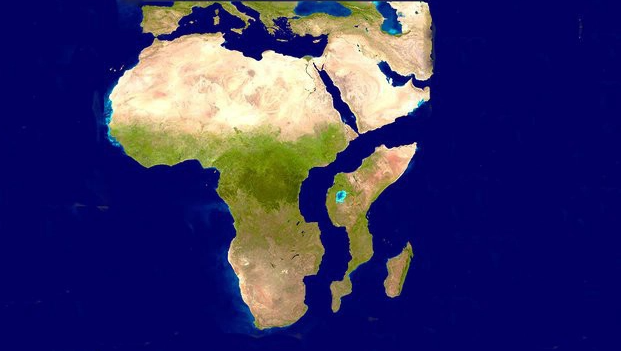The continent of Africa is in the process of splitting in two, which will form a new ocean
- Tram Ho
Research from scientists shows that the complex geological activities of tectonic plates around Africa, which are moving away from each other, will split the continent into two parts. Accordingly, the process will take place over a very long time, up to millions of years, with the ‘end’ that part of East Africa will separate from the rest of the continent, creating a new ocean shape. between two tectonic plates.
According to IFL Science, this separation is related to the East African Rift System (EARS), one of the largest rifts in the world when stretching thousands of kilometers, passing through the territory of several countries countries in Africa, including Ethiopia, Kenya, Democratic Republic of the Congo, Uganda, Rwanda, Burundi, Zambia, Tanzania, Malawi and Mozambique.

Astronaut Samantha Cristoforetti of the European Space Agency (ESA) took this image from the International Space Station while flying over the Gulf of Aden and the Horn of Africa in August 2017. Photo: NASA
According to a 2004 study, the East African Rift System showed that the African continent was splitting into two tectonic plates – the smaller Somali plate and the larger Nubian plate. Both tectonic plates are pulling apart at a slow rate, a few millimeters per year. Although the speed at which the plates are moving is very slow, the researchers say this is clear evidence that a geological change will take place.
As of 2018, news of a crack appearing in Kenya spread rapidly. Many people think that this is proof that Africa is being split in two right before our eyes. While this astonishing sight is related to EARS, however, this is hardly direct evidence of the great split of Africa.
Instead, this may just be a local manifestation of geological activity in the area, which happens quite often. Meanwhile, the faulting process of EARS actually started 25 million years ago, on a much larger scale. In other words, the rift in Kenya is an “indirect whisper” of what is happening on the continent.

Because of the boundary between the Nubian, Somali and Arabian tectonic plates, in an arid region near the Afar depression in Ethiopia, you could be standing exactly where the African continent is splitting in two deep below. ground. Photo: Internet
However, in the next 5 million to 10 million years, changes in EARS could lead to a world with different continents than it is today.
During this time period, we will likely see a new oceanic form between the Somali Plate and the Nubian Plate. The great continent of Africa will lose its eastern ‘shoulder’ and a vast sea will divide East Africa.
It must also be added that the change and movement of tectonic plates or continents is something that has always happened since the Earth’s formation. However, this process happens so slowly that we can hardly feel it clearly.
The Earth’s lithosphere (including the crust and the top part of the mantle) is divided into many tectonic plates, with a total of 16 large tectonic plates, which are huge in size and irregular in shape. These tectonic plates are not stable but move relative to each other at different speeds, “sliding” across the softsphere. The exact mechanism behind their motion is still a subject of controversy, but is certainly related to convection currents within the softsphere and the forces generated at plate boundaries.

Visualize the African continent after it splits in two. In a few million years, part of East Africa will separate from Africa, creating a new ocean between two tectonic plates. Photo: Internet
The land and sea we see today – of Eurasia, the Americas, Africa, Antarctica and Oceania – are the product of vast tectonic plates joined together like a jigsaw puzzle. However, very slowly, these ‘jigsaws’ are still moving around over a period of millions of years.
In fact, if we look at the current world map, we will see a partial trace of the split that took place 138 million years ago, when the continents of South America and Africa split. Accordingly, you will find that they fit together like two pieces of a jigsaw puzzle, showing a past when these two continents were once joined as one.
For Africa alone, over the past 30 million years, the Arabian plate has been sliding further and further away from Africa. The result of this process creates the Red Sea and Gulf of Aden between Africa and the Arabian peninsula.
Of course, the movement of lands usually happens very slowly. Even so, technological advances in GPS devices have revolutionized the field of geology, allowing scientists to make precise measurements of how tectonic plates move over time. real
Refer to IFL Science
Nguồn bài viết : Genk
